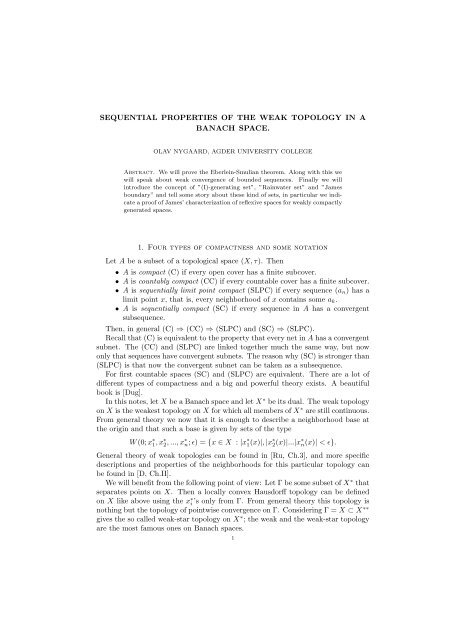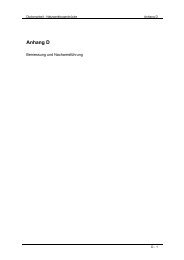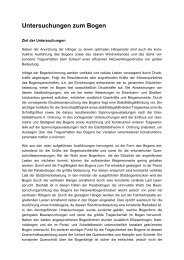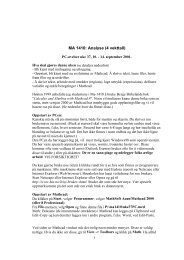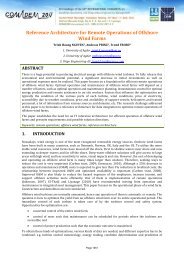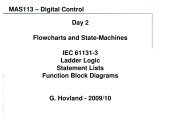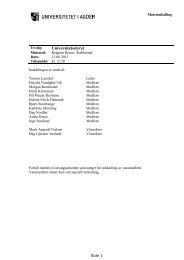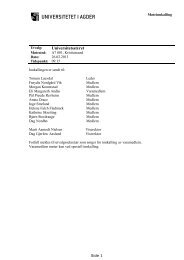SEQUENTIAL PROPERTIES OF THE WEAK TOPOLOGY IN A ...
SEQUENTIAL PROPERTIES OF THE WEAK TOPOLOGY IN A ...
SEQUENTIAL PROPERTIES OF THE WEAK TOPOLOGY IN A ...
Create successful ePaper yourself
Turn your PDF publications into a flip-book with our unique Google optimized e-Paper software.
<strong>SEQUENTIAL</strong> <strong>PROPERTIES</strong> <strong>OF</strong> <strong>THE</strong> <strong>WEAK</strong> <strong>TOPOLOGY</strong> <strong>IN</strong> ABANACH SPACE.OLAV NYGAARD, AGDER UNIVERSITY COLLEGEAbstract. We will prove the Eberlein-Smulian theorem. Along with this wewill speak about weak convergence of bounded sequences. Finally we willintroduce the concept of ”(I)-generating set”, ”Rainwater set” and ”Jamesboundary” and tell some story about these kind of sets, in particular we indicatea proof of James’ characterization of reflexive spaces for weakly compactlygenerated spaces.1. Four types of compactness and some notationLet A be a subset of a topological space (X, τ). Then• A is compact (C) if every open cover has a finite subcover.• A is countably compact (CC) if every countable cover has a finite subcover.• A is sequentially limit point compact (SLPC) if every sequence (a n ) has alimit point x, that is, every neighborhood of x contains some a k .• A is sequentially compact (SC) if every sequence in A has a convergentsubsequence.Then, in general (C) ⇒ (CC) ⇒ (SLPC) and (SC) ⇒ (SLPC).Recall that (C) is equivalent to the property that every net in A has a convergentsubnet. The (CC) and (SLPC) are linked together much the same way, but nowonly that sequences have convergent subnets. The reason why (SC) is stronger than(SLPC) is that now the convergent subnet can be taken as a subsequence.For first countable spaces (SC) and (SLPC) are equivalent. There are a lot ofdifferent types of compactness and a big and powerful theory exists. A beautifulbook is [Dug].In this notes, let X be a Banach space and let X ∗ be its dual. The weak topologyon X is the weakest topology on X for which all members of X ∗ are still continuous.From general theory we now that it is enough to describe a neighborhood base atthe origin and that such a base is given by sets of the typeW (0; x ∗ 1, x ∗ 2, ..., x ∗ n; ɛ) = {x ∈ X : |x ∗ 1(x)|, |x ∗ 2(x)|...|x ∗ n(x)| < ɛ}.General theory of weak topologies can be found in [Ru, Ch.3], and more specificdescriptions and properties of the neighborhoods for this particular topology canbe found in [D, Ch.II].We will benefit from the following point of view: Let Γ be some subset of X ∗ thatseparates points on X. Then a locally convex Hausdorff topology can be definedon X like above using the x ∗ i ’s only from Γ. From general theory this topology isnothing but the topology of pointwise convergence on Γ. Considering Γ = X ⊂ X ∗∗gives the so called weak-star topology on X ∗ ; the weak and the weak-star topologyare the most famous ones on Banach spaces.1
2 OLAV NYGAARD, AGDER UNIVERSITY COLLEGEBut there are clearly more: We could for example let the extreme points of B X ∗be Γ. That case is interesting and well studied. In the theory of Banach algebrasone often works with Γ as the set of multiplicative functionals.Fundamental theorems that we will need are that B X ∗ is compact in the weakstartopology (Alaoglu’s theorem) and that B X is weak-star dense in B X ∗∗ (Goldstine’stheorem). Note further that by definition the formal embedding of X intoX ∗∗ is weak to weak-star continuous. Finally, recall Mazur’s theorem, that forconvex sets the norm-closure and the weak closure coincide.2. Eberlein’s theoremWe are going to prove that if A is a subset of X that is relative sequentiallycompact in the weak topology, then this set is relatively compact in that topology.For this proof we make some preliminary observations.Observation 2.1. If A ⊂ X is relatively sequentially compact, then A is bounded.Proof. Suppose A was unbounded. Then we can find a sequence (x n ) ⊂ A suchthat ‖x n ‖ > n. Thus any subsequence must be unbounded. But according to theBanach-Steinhaus theorem weakly convergent sequences are bounded and hence(x n ) can’t have any convergent subsequence. □Observation 2.2. A bounded set A ⊂ X is relatively weakly compact if and onlyif the weak-star closure of A up in X ∗∗ is in X.Proof. Suppose A is relatively weakly compact and look at the weak-star closure Ãof A in X ∗∗ . This must be the image of the natural embedding since this embeddingis weak to weak-star continuous.Now suppose à ⊂ X. By Alaoglu’s theorem, à is weak-star compact. But on Ãthe weak topology of X and the weak-star topology of X ∗∗ coincide by definition.□Observation 2.3. If E is a finite-dimensional linear subspace of X ∗ , then thereexists a finite set in E ′ ⊂ S X such that for every x ∗ ∈ E‖x ∗ ‖2≤ maxx∈E ′ |x∗ (x)|Proof. Since E is finite-dimensional S E is norm-compact. Thus we can find a 1/4-net F = {x ∗ 1, x ∗ 2, ..., x ∗ n} for E. And we can choose x 1 , x 2 , ....x n in S X such that‖x ∗ i (x i)‖ > 3/4. Now, let x ∗ be arbitrary in E. Thenx ∗ (x k ) = x ∗ k(x k ) + (x ∗ − x ∗ k)(x k ) > 3 4 − 1 4 = 1 2for some appropriate k. Thus, we may simply take E ′ = {x 1 , x 2 , ....x n }.In the last observation here, let us say that ”E ′ finds E”. The point is that atleast half the norm of E’s members is attained on E ′ when E ′ finds E. Clearly, forevery δ > 0, we can take 1 − δ instead of 2, but that doesn’t help us here.We are ready for Whitley’s proof of Eberlein’s theorem, first published in MathematischeAnnalen in 1967. Eberlein’s original proof was published in 1947. Afew years later, Grothendieck showed that Eberlein’s theorem is true in a broaderclass of locally convex spaces, namely those who are quasi-complete in its Mackeytopology. This was done in 1953. Brace gave a proof in 1955 which is the one found□
<strong>SEQUENTIAL</strong> <strong>PROPERTIES</strong> <strong>OF</strong> <strong>THE</strong> <strong>WEAK</strong> <strong>TOPOLOGY</strong> <strong>IN</strong> A BANACH SPACE. 3in the book of Dunford and Schwartz. Pelczynski gave a completely different proofusing basic sequences in 1964. We will follow Whitley’s proof more or less as givenin [D].Theorem 2.4. (Eberlein 1947) Let a subset A of a Banach space X be relativelyweakly sequentially compact. Then it is relatively weakly compact.Proof. According to Observation 1, A is bounded. By Observation 2, what we thenhave to do, is to show that every member of the weak-star closure à of A up inX ∗∗ are in X. This will be done the following way: For x ∗∗ ∈ à we will constructa clever sequence in A. By the relative weak sequential compactness of A, thissequence has a subsequence that converges to some x ∈ X. The cleverness of thesequence is that this subsequence also converges weak-star to that x ∗∗ .Let x ∗∗ ∈ Ã.Step 1: Constructing the sequence.Take some x ∗ 1 ⊂ S X ∗. Look atW 1 = {y ∗∗ ∈ X ∗∗ : |(y ∗∗ − x ∗∗ )(x ∗ 1)| < 1}.Then clearly W 1 is a weak-star neighborhood of x ∗∗ and thus has to contain somea 1 from A. Of course|(x ∗∗ − a 1 )(x ∗ 1)| < 1.That was the first element in the sequence. For the next, letE 1 = [x ∗∗ , x ∗∗ − a 1 ] (norm-closed linear span of x ∗∗ and x ∗∗ − a 1 )and choose a finiteE ′ 1 = {x ∗ 2, x ∗ 3, ..., x ∗ n(2) } ⊂ S X ∗such that E ′ 1 finds E 1 . PutW 2 ={y ∗∗ ∈ X ∗∗ : |(y ∗∗ − x ∗∗ )(x ∗ i )| < 1 }2 , 1 ≤ i ≤ n(2) .Inside W 2 somewhere there has to sit some a 2 ⊂ A, and of course|(x ∗∗ − a 2 )(x ∗ i )| < 1 2 ,1 ≤ i ≤ n(2).Letand pickE 2 = [x ∗∗ , x ∗∗ − a 1 , x ∗∗ − a 2 ]E ′ 2 = {x ∗ n(2)+1 , x∗ n(2)+2 , ..., x∗ n(3) } ⊂ S X ∗such that E ′ 2 finds E 2 . PutW 3 ={y ∗∗ ∈ X ∗∗ : |(y ∗∗ − x ∗∗ )(x ∗ i )| < 1 }3 , 1 ≤ i ≤ n(3) .Inside W 3 again somewhere there has to be some a 3 ⊂ A, and|(x ∗∗ − a 3 )(x ∗ i )| < 1 3 ,1 ≤ i ≤ n(3).Once more, quickly: We putE 3 = [x ∗∗ , x ∗∗ − a 1 , x ∗∗ − a 2 , x ∗∗ − a 3 ]
4 OLAV NYGAARD, AGDER UNIVERSITY COLLEGEE ′ 3 = {x ∗ n(3)+1 , x∗ n(3)+2 , ...x∗ n(4)W 4 ={y ∗∗ ∈ X ∗∗ : |(y ∗∗ − x ∗∗ )(x ∗ i )| < 1 }3 , 1 ≤ i ≤ n(4) .a 4 ∈ W 4 ∩ Aand go on with E 4 to produce W 5 and thus a 5 and so on.Step 2: Some consequences of the contruction.Ok, we have the sequence (a i ). What properties does it have? We know, sinceA is relatively weakly sequentially compact that it has a subsequence (a nk ) with aweak limit x and, by Mazur’s theorem x ∈ [a i ]. But then,x ∗∗ − x ∈ [x ∗∗ , x ∗∗ − a 1 , x ∗∗ − a 2 , x ∗∗ − a 3 ] def= Y.The way Y is built gives us a possibility to control norms there, we have for anyy ∗∗ ∈ Y that‖y ∗∗ ‖≤ sup |y ∗∗ (x ∗ m)|.m2So more than half the norm is found along the sequence x ∗ m. But this is also thecase if we weak-star close Y , and soStep 3: x ∗∗ = x.‖x ∗∗ − x‖ ≤ 2 sup |(x ∗∗ − x)(x ∗ m)|.mThis follows as soon as we can show that for any ɛ > 0 and any m, |(x ∗∗ −x)(x ∗ m)| < ɛ/2. So, let m be arbitrary. We know that x is the weak limit of (a nk ),so x ∗ m(a nk − x) → 0. Thus, we can find a natural number p(m) such that n k > passures |x ∗ m(a nk − x)| < ɛ/4. Now, if necessary, increase p such that n k > p impliesthat also |x ∗∗ − a nk | < ɛ/4. By the triangle inequalityand we are done.|(x ∗∗ − x)(x ∗ m)| ≤ |(x ∗∗ − a nk )(x ∗ m)| + |x ∗ m(x ∗∗ − x)|,A remark is that we have only used very elementary means in a clever way.We needed only the Banach-Steinhaus theorem, Mazur’s theorem and Alaoglu’stheorem from functional analysis, together with basics from topology. Moreover,Observation 1 was used just to avoid stating that A is bounded. Thus, Eberlein’stheorem goes through for bounded sets in any normed space X.If one thought of proving Eberlein’s theorem with pointwise topologies on Γalong the same lines, one quickly comes into many problems. But if Γ has theproperty that bounded Γ-convergent sequences are weakly convergent, then Eberlein’stheorem holds for bounded sets.Definition 2.5. A set Γ ⊂ X ∗ is called a Rainwater set if every bounded Γ-convergent sequence is weakly convergent.We obtain the following theorem:Theorem 2.6. (Generalized Eberlein’s theorem) Let Γ be a Rainwater set in X ∗and assume that A is a bounded set in X. Then, if A is relatively sequentiallyΓ-compact, it is relatively weakly compact.□
<strong>SEQUENTIAL</strong> <strong>PROPERTIES</strong> <strong>OF</strong> <strong>THE</strong> <strong>WEAK</strong> <strong>TOPOLOGY</strong> <strong>IN</strong> A BANACH SPACE. 5We will meet Rainwater sets later on, we just mention now that the extremepoints of B X ∗ provides a such set.3. Smulian’s theoremSuppose A ⊂ X is relatively weakly compact. Then it is weakly bounded, hencebounded. Every sequence in A must now have a weak limit point. We will showthat this limit point in fact is the weak limit of a sequence in A, and this is theessence of Smulian’s theorem. We follow the very wise leadership of Dunford andSchwartz. Recall that a set Γ ⊂ X ∗ is called total if its span is weak-star dense inX ∗ .Theorem 3.1. (Smulian 1940) Suppose a subset A of a Banach space X is relativelyweakly compact. Then it is relatively weakly sequentially compact.Proof. First we show that we may assume X is separable. To this end, suppose thetheorem has been proved in the separable case and let A ⊂ X be relatively weaklycompact. Let (a n ) be a sequence in A. Let Y = [a n ]. Then Y is a separable, closedsubspace. A ∩ Y is relatively weakly compact in Y . Now pick a subsequence (a nk )that converges weakly to some y ∈ Y . Then, since every x ∗ ∈ X ∗ is nothing butan extension of some y ∗ ∈ Y ∗ , (a nk ) converges weakly to y in X as well.So, the situation is reduced to studying a relatively weakly compact compactset A in a separable Banach space X. We take a sequence (a n ) in A, which weknow has a limit point x ∈ X and we try to find a subsequence of (a n ) that couldhave the possibility to converge weakly to x. So, first of all we need a subsequencethat has a tendency of converging weakly to something. For this, suppose H is acountable subset of S X ∗, say (x ∗ n). Look at the collectionx ∗ 1a 1 x ∗ 1a 2 x ∗ 1a 3 x ∗ 1a 4 · · ·x ∗ 2a 1 x ∗ 2a 2 x ∗ 2a 3 x ∗ 2a 4 · · ·x ∗ 3a 1 x ∗ 3a 2 x ∗ 3a 3 x ∗ 3a 4 · · ·....By the Bolzano-Weierstrass theorem, we can pick subsequences such that everyhorizontal line consist of convergent scalar sequences. Assume so has been done.Then take the diagonal sequence, and denote the corresponding subsequence of (a n )by (y n ). By construction lim m x ∗ y m exists for every x ∗ ∈ H, so some kind of weakconvergence seems to emerge.Now we will argue that there is a y 0 ∈ X such that lim m x ∗ y m = x ∗ y 0 for everyx ∗ ∈ H. We know (y n ) has a weak limit point y 0 . This means that every weakneighborhood at y 0 contains at least one (y n ). In particular all the sets{x ∈ X : |x ∗ (x − y 0 )| < ɛ}contains some y m . Since x ∗ y m converges for every x ∗ ∈ H, the limit has to be x ∗ y 0 .This can be done for every countable H. Let us now make H ”big” to get closerto weak convergence of (y n ). Let (x n ) be dense in S X and pick x ∗ n ⊂ S X ∗ such thatx ∗ nx n = 1. Let H = (x ∗ n). Then H is total in X ∗ . To see this, let x ∈ S X be suchthat x ∗ nx = 0 for every n and let x ∗ ∈ S X ∗. Let ɛ > 0 and find some x n such that‖x − x n ‖ < ɛ. Then, since ‖x ∗ ‖ = 1, |x ∗ x| < ɛ. Since ɛ was arbitrary, it followsfrom the Hahn-Banach separation theorem that H is total.
6 OLAV NYGAARD, AGDER UNIVERSITY COLLEGETo end the proof we show that the subsequence (y n ) we obtain with a total Hdoes the trick, that is x ∗ y m → x ∗ y 0 for every x ∗ ∈ X ∗ . Suppose not. Then theremust be some x ∗ 0 ∈ X ∗ , some δ > 0 and some subsequence (y mk ) of (y m ) such that|x ∗ 0(y mk − y 0 )| > δ, k = 1, 2, ...and, by again invoking the Bolzano-Weierstrass theorem, we may assume lim k x ∗ 0y mkexists. But (y mk ) sits in A and has a weak limit point, say y 0. ′ Just as above, weobtain x ∗ y mk → x ∗ y ′ 0 for every x ∗ ∈ H and for x ∗ 0. But thenx ∗ y ′ 0 = x ∗ y 0 for every x ∗ ∈ H,and since H is total, y ′ 0 = y 0 .So |x ∗ 0(y mk − y 0 )| > δ, k = 1, 2, ... and still x ∗ 0(y mk ) → x ∗ y 0 , a hopelesssituation. The theorem is proved.□4. Weak convergence of bounded sequences and a new type ofclosed convex hullIn 1963 (see [R] or [D, p. 155]) the following theorem was published by peoplefrom Seattle under the pseudomym J. Rainwater: For a bounded sequence in aBanach space X to converge weakly it is enough that it converges pointwise on theextreme points of the unit ball in the dual, B X ∗. It is of course this result thatmotivates our term Rainwater set.Later on S. Simons (see [S1]or [S2]) gave a completely different argument to showthat Rainwater’s theorem is true with any boundary of the dual unit ball. So whatis a boundary?Definition 4.1. Let K be a weak-star compact convex subset of X ∗ . A subsetB ⊂ K is called a boundary (or a James boundary) for K if, for every x ∈ X(which we do know attain max on K), the max over K is attained somewhere onB.Observation 4.2. The extreme points of B X ∗ is a boundary for B X ∗.Proof. Let x ∈ X. Let m be the max over B X ∗ and put J = {x ∗ ∈ B X ∗ : x ∗ (x) =m}. Then J is a weak-star closed face (extreme set), and hence it contains anextreme point by the proof of the Krein-Milman theorem.□We formulate Simon’s generalization of Rainwaters theorem:Theorem 4.3. (Simons, 1972) Every boundary for B X ∗is a Rainwater set.Definition 4.4. Let K be a weak-star compact convex subset of X ∗ .B ⊂ K is said toA subset(a) (S)-generate K if K is the norm-closed convex hull of B and K is then saidto be the (S)-hull of B.(b) (W)-generate K if K is the weak-star-closed convex hull of B and K is thenthe (W)-hull of B.(c) (I)-generate K if whenever B is built as a countable union, B = ∪ n B n ,then K is the (I)-hull of B, that is:( )⋃K = ‖ · ‖-clco w ∗ -clcoB n .i
<strong>SEQUENTIAL</strong> <strong>PROPERTIES</strong> <strong>OF</strong> <strong>THE</strong> <strong>WEAK</strong> <strong>TOPOLOGY</strong> <strong>IN</strong> A BANACH SPACE. 7In other words, K is the (S)-hull of the union of the (W)-hulls of the B i ’s.In this case K is called the (I)-hull of B.It is not difficult to see that any (S)-generating set is (I)-generating and that any(I)-generating set is (W)-generating. Moreover, an example can be given to showthat the (S)-hull in general lies strictly in between the (S)-hull and the (W)-hull.It can also easily be seen that to produce the (I)-hull of B we can take increasingunions. In this case the union is itself convex and we end up with only takingnorm-closure of the union of the (W)-hulls.Here is an illustration of how the fact that B (I)-generates B X ∗ can be used inproving theorems (compare to Rainwater-Simons’ theorems):Theorem 4.5. Let X be a normed space and suppose B (I)-generates B X ∗. ThenB is a Rainwater set.Proof. Let (x i ) be a bounded sequence in X that converges pointwise on B. Wemust show that (x n ) is weakly convergent. Let M be such that ‖x i ‖, ‖x‖ ≤ M forall i. Pick an arbitrary x ∗ ∈ B X ∗ and let ɛ > 0. DefineB i = {y ∗ ∈ B : ∀j ≥ i, |y ∗ (x j − x)| < ɛ}.Then, since y ∗ (x i ) → y ∗ (x) for every y ∗ ∈ B, (B i ) is an increasing covering of B.Since B has property (I), there is a y ∗ in some w ∗ -clcoB N such that ‖x ∗ −y ∗ ‖ < ɛ.Note that for every y ∗ ∈ w ∗ -clco B N , j ≥ N implies that |y ∗ (x j − x)| ≤ ɛ. Now,the triangle inequality show that for j ≥ N|x ∗ (x j − x)| ≤ |x ∗ (x j ) − y ∗ (x j )| + |y ∗ (x j ) − y ∗ (x)| + |y ∗ (x) − x ∗ (x)|≤ (1 + 2M)ɛ,and hence (x i ) converges weakly to x.The property that B (I)-generates K was introduced by Fonf and Lindenstraussin a recent paper, see [FL]. Here the following theorem is the main observation:Theorem 4.6. (Fonf-Lindenstrauss, 2003) Suppose B is a boundary for K. ThenB (I)-generates K.Note that Simons’ theorem follows from the two theorems above. Another corollaryis the following:Corollary 4.7. Suppose every x ∗ ∈ B X ∗ attain its norm on B X . Then X is aGrothedieck space, that is, every weak-star convergent sequence in X ∗ is weaklyconvergent.Proof. That every x ∗ ∈ B X ∗ attain its norm on B X tells us exactly that B X is aboundary for B X ∗∗. By the Fonf-Lindenstrauss theorem B X (I)-generates B X ∗∗.Now, let (x ∗ n) be a weak-star convergent sequence in X ∗ . Then, by the Banach-Steinhaus theorem, it is bounded. By definition it converges pointwise on B X .Hence, by Theorem 4.5 it is weakly convergent.□A much stronger theorem than the above corollary is true. This is a difficulttheorem of R. C. James and reads as follows: Let X be a Banach space. Supposeevery x ∗ ∈ B X ∗ attain its norm on B X . Then X is reflexive. James’ theoremfor a big class of spaces follows, however from the above corollary and Eberlein’stheorem:□
8 OLAV NYGAARD, AGDER UNIVERSITY COLLEGECorollary 4.8. Let X be a Banach space such that B X ∗ is sequentially weak-starcompact. If every x ∗ ∈ B X ∗ attain its norm on B X , then X is reflexive.Proof. We need only observe that any Grothendieck space with a weak-star sequentiallycompact dual unit ball is reflexive. To prove this we will show that then B X ∗is weakly compact, which is equivalent to X being reflexive. By Eberlein’s theoremwe need only show it is weakly sequentially compact and so it clearly is, by theGrothendieck property.□Which spaces have weak-star sequentially compact dual unit balls? Well, separablespaces for sure, since then B X ∗ in its weak-star topology is metrizable. Itis a theorem (not very difficult, one only needs the so called Davis-Figiel-Johnson-Pelczynski construction) of Amir and Lindenstrauss that every subspace of a weaklycompactly generated space (WCG-space) is also of this type. A WCG-space is aspace where one can find a weakly compact set such that the span of that set isdense.Definition 4.9. A Banach space such that B X (I)-generates B X ∗∗ is called an(I)-space.Note that by Goldstine’s theorem, every Banach space is a (W)-space (the definitionshould be obvious) and that the (S)-spaces are exatly the reflexive spaces.Question 4.10. Who are the (I)-spaces?ReferencesD. J. Diestel, Sequences and Series in Banach Spaces, Graduate Texts in Mathematics, vol. 92,Springer, 1984.DU. J. Diestel and J. J. Uhl, jr., Vector Measures, Math. Surveys, vol. 15, Amer. Math. Soc.,1977.Dug. J. Dugundji, Topology, Allyn and Bacon, inc., Boston, 1966.FL. V. P. Fonf and J. Lindenstrauss, Boundaries and generation of convex sets, Israel. J.Math. 136 (2003) 157-172.R. J. Rainwater, Weak convergence of bounded sequences, Proc. Amer. Math. Soc. 14 (1963)999.Ru. W. Rudin. Functional Analysis. 2. ed. Mc. Graw-Hill (1991).S1. S. Simons A convergence theory with boundary. Pacific J. Math. 40 (1972) 703-708S2. S. Simons An Eigenvector Proof of Fatou’s Lemma for Continuous Functions. The Math.Int. 17 (No 3) (1995) 67-70


